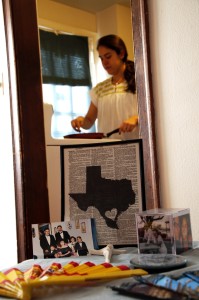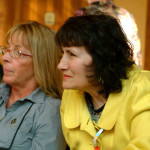This article aims to answer the question, “How can a visual culture jam be utilized to foster Culturally Responsive Art Education (CRAE)?” My master’s research project provides the data needed to approach this question. I conducted my project during Fall 2012 at a mid-Atlantic research-based university as an assignment in a pre-service art education Capstone course[1]. My participants were senior level, pre-service art educators, who were about to embark on student teaching during Spring 2013. The curriculum was centered on a performance-based art project in which participants created “visual culture jams” as a form of critical self-reflections of their own cultural, ethnic, and racial identities. The performance of these visual culture jams disrupted the notion of “essentializing” cultures and encouraged participants to probe their cultural identity (Sleeter, 2012, p. 570). My arts-based research project took place over a period of three class sessions and data includes digital self-portraits, narrative responses, and video recorded performances of my participants’ visual culture jams. Performances will be discussed through the following emergent themes: family as culture, heritage, and other forms of identity. My own reflection on the project will conclude this article and consider whether or not CRAE was successfully implemented.
Cultural disruption

“You’re fluent in Spanish, right?” This is a simple question. One that merely seeks to get to know and understand someone’s background and experiences. When asked to me, however, a cascade of emotions converges upon me. I experience a small sense of doubt, guilt, disconnect, and shame because I was raised in South Texas and born to parents who were raised speaking Spanish. However, I do not know Spanish—at least not yet. This simple question, therefore, instigates a “personal culture jam” in my life. A personal culture jam is a term that I have adopted to denote moments in a person’s life when they experience a moment of disruption in their cultural identity. It causes someone to stop and reflect, to realize they do not fit into the “norm” of a socially-defined culture.
A culture jam, in its original conception, is a contemporary art form practiced by cultural activists who seek to question the everyday practices of society through large, and very public, forms of activism (Darts, 2004). A staple example of culture jammers is a group known as the Yes Men[2], whose work includes impersonating members of global organizations and giving speeches that act against the values of the organization in order to prompt reaction and questioning. Another group, the Guerrilla Girls[3], works specifically within a visual context and seeks to question the gender boundaries surrounding the art and museum world. Still, culture jamming has begun to take form in broader forms and become a form of visual and verbal questioning done by multiple people of all ages in various environments (Beck, 2012; Martinez, 2012; Monroe, 2012; The Sociological Cinema).
Inspired by my own experiences with cultural disruption, I sought to create a curriculum project that would bring these “jamming” experiences into the classroom. As Maxine Greene (1995) states, “An ability to take a fresh look at the taken for granted seems equally important; without that ability, most of us, along with our students, would remain submerged in the habitual” (p. 100). These experiences, when translated into the classroom, supply students with the disruption needed to “take a fresh look” and reflect on their everyday life experiences in relation to their race, ethnicity, and/or culture. In order to understand how this curriculum can be best implemented, we must become familiar with culturally-based pedagogy, like CRAE, and understand its goals and practices.
CRAE
“Students and instructors often bring preconceived ideas, attitudes, and beliefs related to race with them into the classroom. This indirectly and directly affects teaching and learning by closing off the opportunity for open inquiry and dialogue” (Lee, 2012, p. 51).
As this quote demonstrates, it is important for educators to understand how their personal lives can affect their teacher lives, especially in regard to their (mis)conceptions of students and their cultural identities. A pedagogy that seeks to integrate cultural identity/history into the K-12 classroom is Culturally Responsive Teaching (CRT). CRT advocates for the inclusion of the whole child into the curriculum, meaning teachers should integrate student cultural histories and traditions into the classroom in order to implement meaningful and impacting curriculum. At its best, CRT is validating, comprehensive, multidimensional, empowering, transformative, and emancipatory (Gay, 2010). The culmination of these characteristics supplies students with positive experiences with their cultural identity and enables their “cultural frames of reference” to become an important, heard perspective in the classroom (Gay, 2010, p. 26).
This pedagogy became the framework of my emerging curriculum as I sought to connect it with the field of art education. Connection was made through the writing of scholars within multicultural art education and diversity art education (Ballengee-Morris & Stuhr, 2001; Garoian, 2003; Hanley, 2011; Lee, 2012; Lai, 2012; Millman, 2010; Stuhr 1994). I have gathered that CRAE seeks to achieve CRT through an artistic and visual means. CRAE enables students to explore their cultural history and tradition through various art forms—painting, photography, performance, etc.—and understand their cultural group’s positioning within art history. This art pedagogy also invites students to critique and comment on social practices, in order to create and foster more empathetic, democratic perspectives.

As I was conducting my literature review, one article that truly impacted my research was “Multicultural art and visual cultural education in a changing world,” written by Christine Ballengee-Morris and Patricia Stuhr (2001). Early in their article, they state, “A recognition of our own sociocultural identity and our biases make it easier to understand the multifaceted cultural identities of others (Ballengee-Morris & Stuhr, 2001, p. 7).” Further reflection upon this quote, and my own positioning as a pre-service art educator preparing for student teaching, led me to realize the necessity of self-reflection on cultural identity during pre-service education. This realization informed my research problem statement:
Before students can experience Culturally Responsive Art Education, their teachers need more meaningful opportunities to critically reflect on issues of culture, ethnicity, and race in relation to their own identities and biases.
As members of American society, we are surrounded by a color-blind society that believes it is inappropriate to discuss issues surrounding race/ethnicity/culture in a public setting (Grossman & Charmaraman, 2009; Jupp & Slattery, 2012; Lee, 2012; Sleeter, 2012). However, in order for pre-service educators to become more comfortable discussing these issues, they must experience a safe, non-judgmental environment and pedagogy that eases into these discussions. CRAE, if practiced with the best intention, encourages and facilitates discussions of race, ethnicity, and culture, making it possible to critique color-bind ways of seeing and strengthen educators’ understanding of how their personal beliefs affect their worldview and interaction with their students (Ballengee-Morris & Stuhr, 2001; Lee, 2012). My research project utilized CRAE as a pedagogy and curriculum framework in order to instigate self-reflection upon one’s cultural identity and discuss these issues in relation to future teaching practice.
[1] The curriculum was presented to the students as an assignment in the course, and I presented the project to the students. They were given an IRB consent form and told that while they must take part in the curriculum, they could choose to deny me access to their data as research material.
[2] To learn more about The Yes Men and their work, visit their website: theyesmen.org.
[3] To learn more about the Guerrilla Girls and their work, visit their website: www.guerrillagirls.com.